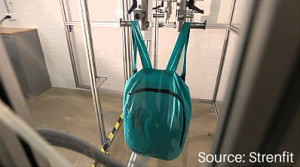 You’re waiting for what seems like an eternity with all the other restless travelers when the bags start to roll out on the conveyor belt. You start to think they might have lost your bag, but then you spot it!
You’re waiting for what seems like an eternity with all the other restless travelers when the bags start to roll out on the conveyor belt. You start to think they might have lost your bag, but then you spot it!
Feeling just a bit more awake now, you get into position to grab the suitcase that you bought new for the trip. Your hand closes around the handle as you struggle briefly to pull the bag from the luggage carousel. Just when you think you’ve got it, the seam around the zipper tears apart and your clothes rain down like confetti.
Many of us have had a bad experience with buying a cheaply made bag. Chances are that cheap bag wasn’t tested for quality and durability before leaving the factory that made it. And whether you’re an importer of bags or an end consumer, it pays to be familiar with these simple tests for bags and suitcases typically carried out during product inspection.
1. Load test for bags and suitcases
A bag’s ability to withstand a certain weight without falling apart is essential. The good news is that the load test used for this is easy to perform and doesn’t require special equipment. It’s also among the most standard tests for bags and suitcases.
The load test is performed on bags with handles. A solid-made bag is typically manufactured to carry more than the maximum load printed on the rating label.
"A solid-made bag is typically manufactured to carry more than the maximum load printed on the rating label."The procedure for load testing
To carry out the load test for a bag:
- Load the bag with the maximum weight shown. If no maximum weight is shown, load with the weight specified below.
| Bag Size (length + width) |
Weight Load | ||
| Inches | Centimeters | Pounds | Kilograms |
| < 25 | < 64 | 20 | 9.1 |
| 25 - 45 | 64 - 114 | 30 | 13.6 |
| > 45 | > 114 | 50 | 22.7 |
- Lift the bag up and down 20 times by the handles.
- Hang the bag up for four hours.
- Check for damage. If you find damage to the handles or the bag itself after this time, the bag fails this test.
2. Jerk test for bags and suitcases
Bags with handles often need to withstand a sudden force. For example, if you go to lift a bag quickly, you want to be sure that pulling on the handles suddenly won’t rip the bag. With this in mind, the jerk test is one of the most important tests for bags and suitcases product inspectors will often perform before a bag ships.
The procedure for jerk testing
To carry out the jerk test for a bag with handles:
- Add a load to the bag equal to half the maximum rated weight or half the weight specified in the table above.

- Slide a bar horizontally through the handles of the bag to allow the bag to hang freely in the air.
- Lift the bag by the bottom to ½ to ¾ of the vertical height of the handle.
- Drop the bag so it free-falls and hangs again by the handles.
- Repeat this process at least five times and check for damage to the bag and handles. If there is damage to the bag or handles, the bag fails this test.
3. Fatigue test for bags and suitcases
Just as a bag’s handles are important for carrying a bag, other parts are intended to keep the contents of the bag inside during transport. Tests for bags and suitcases should also include fatigue testing designed to check the durability of the bag’s fasteners.
"Inspection tests for bags and suitcases should also include fatigue testing."The procedure for fatigue testing
To carry out fatigue testing:
- Operate all buttons, zippers, Velcro, accessories and adjustable parts repeatedly 50 cycles. For paper and plastic bags, an additional fatigue test is performed which involves folding and opening the bag 50 times.
- Check for loss of function. If the bag fails to smoothly open and close using any of the adjustable components, the bag fails this test.
4. Abuse test for bags and laptop cases
The abuse test is performed on the straps and buckles of shoulder bags and laptop cases. This test checks tensile strength, the amount of direct force the strap and buckles can withstand when being pulled. Abuse testing is especially important for bags and laptop cases with a single strap, since weight is not distributed to a second strap.
The procedure for abuse testing
- Secure the shoulder strap to the side buckles.
- With the bag held in place, pull the strap from one side at a time using a tension gauge with a force of up to nine kilograms gradually for 5 seconds.
- Maintain force with the tension gauge for 10 seconds.
- Check the bag’s strap and buckles for damage and function. The bag fails this test if strap of buckle functionality is reduced or there is damage.
5. Item drop test for bags and suitcases
Some tests for bags and suitcases are meant to simulate rough handling experienced during travel. Luggage, in particular, is often roughly tossed around as it’s loaded and unloaded at airports and hotels. The item drop test is an important test that aims to make sure your luggage isn’t broken or damaged during transit.
"The item drop test aims to make sure your luggage isn’t broken or damaged during transit."The procedure for the item drop test
To conduct the item drop test for luggage:
- Load the bag with a 25kg weight.
- Drop the bag on all 6 sides from a height of one meter.
- Check the bag for damage. The bag fails this test if you find any damage or deformation.
Conclusion
There are a variety of tests that should be performed on your bags during product inspection before they leave the factory that manufactures them. These five tests will help you ensure your bags are able to withstand everyday use.
Whether they’ll be used for hauling school books, carrying groceries or will be shaken up in the cargo hold of an airplane, consider the value of your bag’s contents when deciding how important quality is to you. And if you’re an importer of bags, be sure to incorporate the relevant on-site tests for bags and suitcases in your next product inspection.








